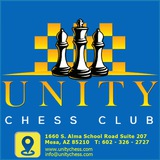After 20...Qxd4, White wins by 21.Qxd4! Bxd4 22.Bxe6 Rxf7 23.Bxf7+ Kxf7 24.Rc7 Bf6 25.Bc3 Re8 26.Bxf6 Kxf6 27.Rxb7±.
Bad is 21...Qxd4 22.Qxd4 Bxd4 23.Rxe7+–.
Black had counted on the pin, but...
Black had counted on the pin, but...
For the queen, White has rook, bishop and two pawns, but Black’s biggest problem is the weakness of g7. The attack is unstoppable.
Not 26.Ke1 Qe5+, and Black wins.
Black resigned. There could follow 26...Bxe2+ 27.Ke1 (of course, not 27.Kxe2 Rfe8+ 28.Kf3 Qc6+ 29.Kg4 Qxg2+–+) 27...Qa5+ 28.b4, with inevitable mate.
Black resigned. There could follow 26...Bxe2+ 27.Ke1 (of course, not 27.Kxe2 Rfe8+ 28.Kf3 Qc6+ 29.Kg4 Qxg2+–+) 27...Qa5+ 28.b4, with inevitable mate.
Unity Chess Club
Robert Fischer Pal Benko New York ch-USA 1963 White to move
Black’s hopes are exclusively tied up with advancing the f-pawn. The following typical blockading sacrifice prevents this.
